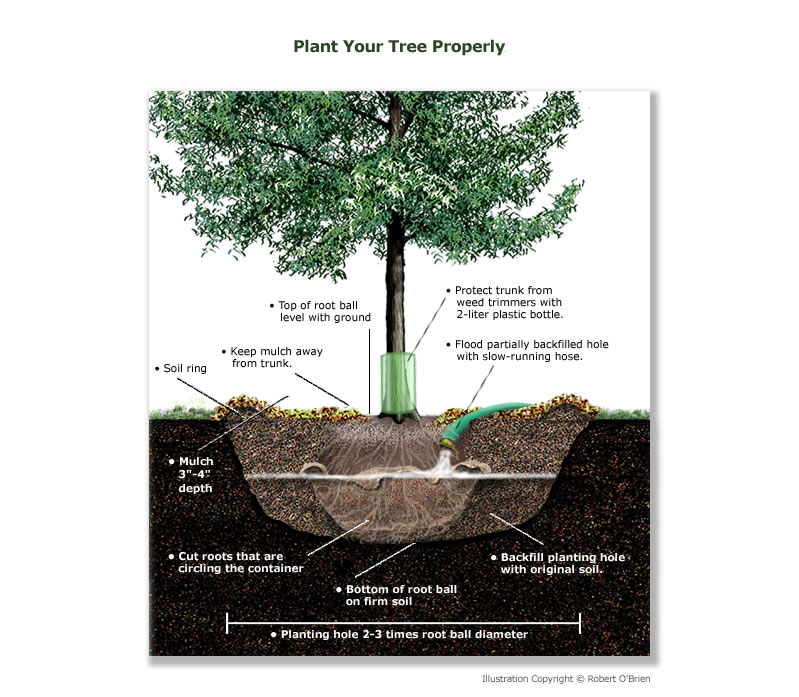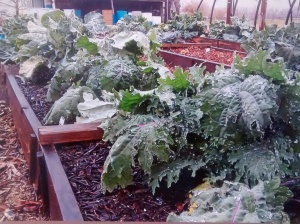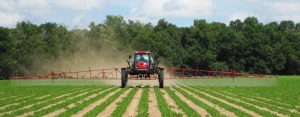
The changing of the seasons to cooler weather with periodic freezes
leaves gardeners missing the warmer temperatures. Serious gardener find a
way to garden on the fringes of the seasons. Using methods to extend
the growing season can allow harvesting to extend through the fall and
early winter, and allow earlier planting in late winter and early
spring. Check out this great article written by my colleague and friend, Skip
Richter, Harris County Horticulture Agent.
Protecting Plants from Frosts and Freezes
Written by Robert “Skip” Richter
County Extension Agent – Horticulture
Fall,
winter and spring bring the danger of frosts and freezes to our gardens
and landscapes. An early fall frost can bring an end to our warm season
gardens, while the threat of spring frosts make gamblers of tomato
growers, and worriers of anyone with a peach tree in full bloom. Winter
cold threatens plants that are marginal in our zone.
The Science of Frosts and Freezes
When
the water inside a plant freezes it forms ice crystals that pierce the
plant’s cell walls. When the temperature warms up, the cells leak out
their fluids as they die and turn to mush. Freeze damage first shows up
as dark, water-soaked tissues which then turn brown or black and dry up.
Frost
appears on the surface of plant tissues and other exposed surfaces.
During the night, these surfaces radiate heat to the sky. When the
temperature of an object drops to the dew point, the water vapor
contacting the object freezes on the surface. This is similar to water
condensing on your iced tea glass because the glass is colder than the
air around it.
Can you have a frost without a freeze? The answer is
yes…and no. It is possible for frost to form when the air temperature is
above freezing. For example, solid surfaces lose heat faster than air
on a cold night. The windshield on your car radiates its heat, dropping
in temperature faster than the air around it. As a result, we see frost
on a windshield when the surrounding landscape may not show frost. Those
surfaces with exposure to clear sky cool more rapidly at night than
understory plants or surfaces that have a shelter above them to slow
their radiation loss.
Plants similarly may lose radiation on clear
sky nights and be colder than the measured air temperature. On a cold
night, the surface of a leaf can drop as much as 5 degrees Fahrenheit
below the temperature of the air around it causing frost to form on its
surface. So you can have a frost without the temperature of the air
dropping below freezing, but frost is a sign that the plant tissues have
dropped below freezing.
Anything that reflects the radiating heat
back down will deter frost formation. For example, you may have noticed
frost on your lawn where it is exposed to the sky but not beneath a tree
canopy or picnic table. Clouds perform the same radiant heat-reflecting
function. On a clear night, temperatures drop fast. On a cloudy night,
some heat is reflected back to the ground slowing the temperature drop
and in many cases preventing a frost.
Early fall or late spring radiative frosts are usually brief as the temperature drops just below freezing at
the end of the night and then rise above freezing soon after the sun
comes up. We can do a lot to protect plants on a still night when the
temperature doesn’t drop too low and the duration is brief.
On the
other hand, when a hard freeze hits with windy conditions and lasts for a
day or more it is more difficult to protect our gardens. The wind
displaces any heat that might have helped protect the plants and speeds
cooling of plant tissues.
The first parts of plants to freeze are
tender new growth and the areas between leaf veins where the leaf is
thinnest. Some plants vary in cold hardiness as they grow and mature,
and not all plant parts are equally cold hardy. Broccoli, for example,
is quite hardy as a strong, growing plant but the flower buds, the part
we eat, are much more sensitive to cold.
Plant Protection Techniques
Our winters are usually brief with moderate to cool
temperatures typified by several mild frost events but only occasional
severe freezes. Here are a few techniques to help avoid frost or freeze
damage to landscape and garden plants.
Watering
Plants under
drought stress are more susceptible to cold damage. Water plants several
days before cold weather threatens to alleviate drought stress. Water
is also a great “heat sink.” That is, it holds warmth and releases it
slowly over the course of a long cold evening. This alone won’t provide
protection from a hard freeze but can be used with covers to make a
difference on mild frost night, and every little bit helps!
You may
have also seen commercial fruit producers sprinkle plants with water on a
cold night. This works because water gives off energy (heat) as it
changes it’s state from liquid to solid (ice). A gallon of water weighs
8.3 pounds and yields 1,200 Btu’s of heating power as it freezes. That
is the key to using water to protect plants.
Water is sprinkled on
the plants and then freezes releasing a small amount of heat as it
changes from liquid to solid form. Then another water drop lands and
freezes releasing more heat. As long as there is a thin layer of liquid
water on the surface, the interior of the ice coating on a branch will
not drop below about 32 degrees Fahrenheit. A common misconception is
that the ice is insulating the plant tissues against the cold, but ice
is a poor insulator, so once new droplets of water stop being applied,
the leaves or branches also continue to cool below 32 degrees Fahrenheit
and may be damaged.
So why not just sprinkle plants and be done with
all this worrying over freezes? If the freeze is not too severe or too
long AND if you can install sprinklers that put out a small amount of
water constantly over time, it could be a feasible strategy. However,
lawn sprinklers put out too much water and when left on overnight can
create very soggy soil conditions that exclude oxygen from a plant’s
roots. If the freeze lasts very long the accumulating ice load can break
trees and shrubs, and flatten garden plants.
If you use sprinklers,
you must start watering before the air temperature reaches 32 (so that
sprinklers are not stopped up with ice) and continue to water through
the night and next morning until the temperature rises far enough above
32 degrees Fahrenheit that the ice is rapidly melting. Otherwise the
process works in reverse. As the ice goes from solid to liquid water it
absorbs heat causing super cooling in the branch or leaf tissues inside
the ice. A familiar example of this is homemade ice cream. When the salt
causes the ice to change to liquid it pulls heat out of the ice cream
mixture causing it to freeze! Therefore protecting plants with
sprinklers, while possible in some situations requires a large volume of
water and is seldom a viable landscape or garden option.
Covering PlantsCovering
plants with sheets, blankets, or rowcovers is the simplest, most
practical way to protect against a frost or freeze. Keep in mind,
however, that a blanket doesn’t keep a plant warm, at least not to any
significant degree. Blankets keep us warm because our bodies produce
heat that the blanket helps hold in. If you wrap up the branches of a
small tree or shrub with a blanket you aren’t doing it much good other
than some minor slowing of the cooling process. The practice of covering
a plant and tying the cover to the trunk creates “landscape lollipops”
which are still quite susceptible to the cold temperatures.
On a cold
night, warmth from the soil rises up around the plants. A blanket can
help trap this warmer air within the plant’s canopy and make a
significant difference on a cold night. The air need not be warm, just
warmer than freezing. If you keep the air temperature around plants from
dropping below freezing you have accomplished your goal. Even cool soil
is significantly warmer than freezing air and thus a source of “warmth”
on a cold night.
To cover plants effectively, lay the cover over the
plant and allow it to drape down to the soil on all sides. Then secure
it with boards, bricks, rocks, or soil to hold in the air. Sealing the
air inside the cover prevents a breeze from cooling the plant down
faster. The next day, remove the covers to allow the sun to warm the
soil surface a little and then replace the covers just before sundown,
if another freeze is forecasted. Spunbound polyester rowcover fabric
works quite well in holding heat. The lighter weight types are not as
effective as the heavier types, which are generally sold as “frost
blankets”.
When you run out of sheets, blankets, or frost cover
material, you can use cardboard boxes and large garbage cans to cover
plants. Plastic sheeting or any material that radiates its heat out
quickly will freeze damage plant tissues where it touches them. Clear
plastic also tends to not reflect the radiant heat back down as well.
Plastic is good, however, for holding in the air on a windy night so it
is sometimes helpful to cover the blanket or sheet with plastic when it
is going to be breezy and cold.
Another technique is to set up hoop
tunnels with 1/2” PVC pipe stuck into the ground to form a series of
arched hoops down the row. You can also drive short sections of 3/8”
rebar into the soil and then slide the PVC onto them. Space the hoops
about 4 feet apart and attach another piece of PVC down the row along
the top of the hoops for added support. The hoop tunnel is useful for
preventing a tarp or other heavy material from crushing plants. Longer
PVC arches can also be used to create a structure to hold a tarp over a
citrus or other valuable small tree or shrub.
Adding HeatAdding a
source of heat beneath a cover can make a big difference, especially if
you have a good cover that is secured to prevent wind from moving the
warmer air out from beneath it. Common heat sources include a
mechanic’s light, a clamp on flood light, or a string of Christmas
lights (the ones with large bulbs, not the very small ones that don’t
put out any heat). Check for shorts in the wiring and make sure rain or
other moisture can’t get into the fixtures. Don’t allow
a hot light bulb to come close to plant tissues or it can cause damage. When
protecting
small plants such as tomato transplants, a container of water such as a
milk jug can provide a little warmth. Place one or two jugs right up
against a new transplant to provide maximum protection. The larger the
container of water, the more latent heat it can hold.
Soil and MulchMulch
is a great way to protect tender perennials that are marginally hardy
in our climate. Prune back the plants to near the soil and cover it with
a thick mulch of hay or leaves to hold in the soil’s warmth.
Soil is
also a good plant protector during freezes, because it transfers the
heat of the earth to the plant parts that it contacts. Citrus growers
often mound soil up around the base of the tree’s trunk when a hard
freeze is forecast. If the top portion of the tree is lost they will
still have a strong root system and graft union above which a new tree
can sprout and regrow, saving the expense of replanting new trees.
If
you have citrus trees in the landscape, consider adding this measure of
protection when a hard freeze is forecast. Use a loose, lightweight
soil such as a sand or sandy loam and pull it back away after the danger
of frost is past to avoid promoting rot diseases of the lower trunk.
The soil mound should be in contact with the soil below the lower limbs
and above the graft, but not heaped on top of mulch or leaves which
breaks the contact of the soil mound with the soil in the surrounding
earth.
Protecting Container Plants
The roots of plants growing in
containers lack the insulation of the earth and will get much colder
than roots of in-ground plants. Roots are often less hardy than the top
portions of the plant, sustaining root death when temperatures in the
container drops much below 32 degrees Fahrenheit.
A garage or other
protected location is a good way to protect container plants during a
killing freeze. The next best option is to mass the containers close
together on a protected side of the home or other structure. For added
protection pile leaves over the containers and/or place a tarp or
blanket over them.
Assessing Damage After A Freeze
After a freeze
is over, damaged plant tissues may show up immediately as water soaked
or withering foliage. Cold damage to branches or trunks often doesn’t
show up right away. Wait a few days and then use a knife or thumbnail to
scrape back the outer bark on young branches. Cold damaged areas will
be brown beneath the bark, while healthy tissues will be green or a
healthy creamy color. If in doubt, wait to prune out any cold damage
until new growth begins in the spring. It will then be evident how far
back to prune the plant to remove any freeze damaged areas.
Download a copy of this article here:
harris.agrilife.org/files/2014/01/Extending-Growing-Season.pdf







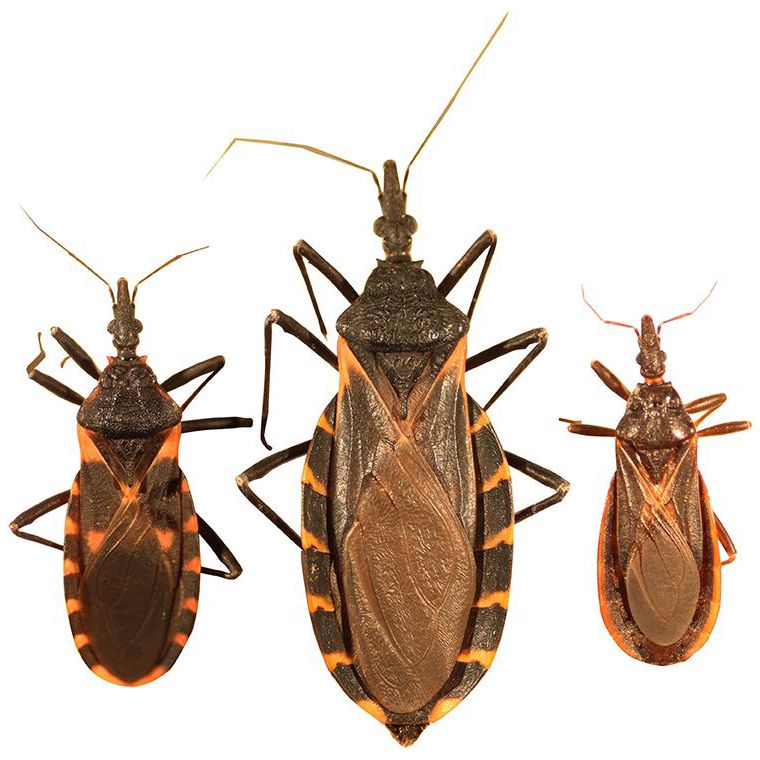
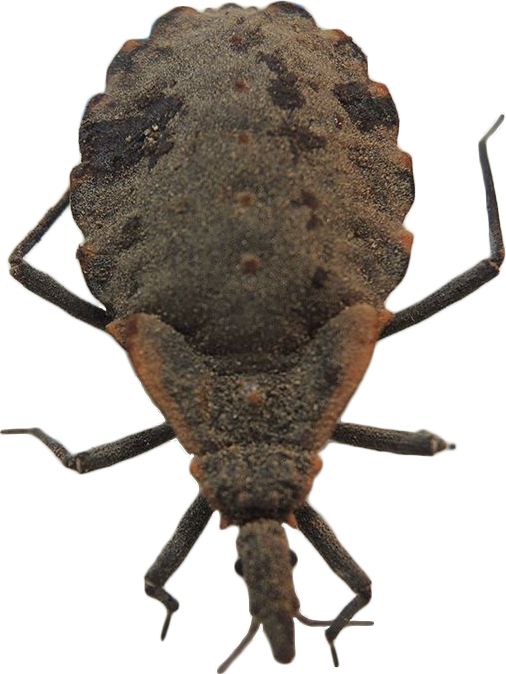




.jpg)
